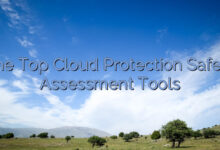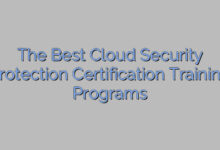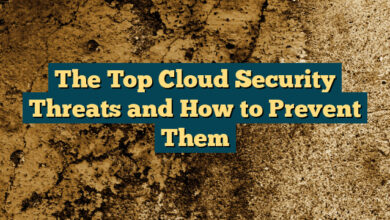The Top Cloud Security Protection Solutions for Your Business
Contents
- 1 Introduction: Protecting Your Business in the Cloud Age
- 2 1. Encryption
- 3 2. Multifactor Authentication
- 4 3. Cloud Access Security Brokers
- 5 4. Cloud Security Posture Management
- 6 5. Data Loss Prevention
- 7 6. Security Information and Event Management
- 8 7. Cloud-native Security Solutions
- 9 The Top Cloud Security Protection Solutions: A Comparison
- 10 Frequently Asked Questions
- 10.1 1. How can I know if my cloud service provider is secure?
- 10.2 2. How often should I update my cloud security policies?
- 10.3 3. Can cloud-native security solutions work with multiple cloud providers?
- 10.4 4. What are some common misconfigurations that can lead to cloud security breaches?
- 10.5 5. Can cloud security protection solutions protect against all cyber threats?
- 10.6 6. How do I choose the right cloud security protection solutions for my business?
- 10.7 7. What are some best practices for cloud security?
- 11 Conclusion: Protect Your Business in the Cloud
- 12 Closing Words: Protect What Matters Most
Introduction: Protecting Your Business in the Cloud Age
Hello visitors! As businesses increasingly move to the cloud, ensuring the security of your organization’s data has never been more important. Cloud services offer many benefits, like scalability, cost-effectiveness, and flexibility, but they also introduce new risks. In this article, we will explore the top cloud security protection solutions for your business, so you can safeguard your data and operations in the cloud.
First, let’s take a closer look at the cloud security landscape and some of the risks you should be aware of.
The Risks of Cloud Computing
Cloud computing is not without its challenges. When entrusting your data to a cloud service provider, you need to be aware of the risks involved. Here are some of the most common:
1. Data Breaches: Cybercriminals are constantly looking for ways to breach the security of cloud systems. Once they gain access to your data, they can use it for a variety of nefarious purposes, like identity theft and fraud.
2. Insider Threats: Even well-meaning employees can cause problems when working with cloud services. They might inadvertently leak data, or intentionally steal it for their own purposes.
3. Compliance Violations: Your business might be subject to regulations, like GDPR or HIPAA, that require you to take specific steps to protect sensitive data. If you’re not careful, your cloud services could leave you exposed to compliance violations and hefty fines.
The Top Cloud Security Protection Solutions
To help mitigate these risks, there are many different cloud security protection solutions available. Let’s explore some of the most effective:
1. Encryption
Encryption is a security technique that encrypts data so that it can only be read by someone who has the key to unlock it. By implementing encryption, you can protect your sensitive data from falling into the wrong hands.
Emojis: 🔐
How Encryption Works
Encryption is a complex process that uses mathematical algorithms to scramble data. The data is then stored or transmitted in an encrypted form, and can only be decrypted using the appropriate key. The key should be kept separate from the data, so that if someone gains access to the data, they still can’t read it without the key.
Strengths: Encryption is a powerful technique for protecting sensitive data. It can help you meet compliance requirements, as well as improve your overall security posture.
Weaknesses: If the key is lost or stolen, you could lose access to your own data. Additionally, encryption can introduce additional complexity into your systems.
2. Multifactor Authentication
Multifactor authentication (MFA) is a security technique that requires users to provide multiple forms of identification before being granted access to a cloud service. By implementing MFA, you can prevent unauthorized access to your systems and data.
Emojis: 🔐👤
How MFA Works
MFA requires users to provide more than one factor of identification before they can access a cloud service. Typically, this involves something the user knows (like a password) and something they have (like a token or smartphone). Some systems might also require a biometric factor, like a fingerprint or iris scan.
Strengths: MFA is an effective way to improve the security of your cloud services. By requiring additional forms of identification, you can make it much harder for attackers to gain access to your data.
Weaknesses: MFA can be inconvenient for users, and might slow down the login process. Additionally, some forms of MFA, like SMS-based authentication, can be vulnerable to attacks.
3. Cloud Access Security Brokers
Cloud access security brokers (CASBs) are third-party security solutions that sit between your organization and your cloud service providers. They provide a range of security functions, like data loss prevention, access control, and threat detection.
Emojis: 🛡️🔒
How CASBs Work
CASBs act as intermediaries between your organization and cloud service providers. They monitor and enforce security policies, like access control and data loss prevention, across your cloud services. They can also detect and respond to threats, like malware and suspicious user behavior.
Strengths: CASBs provide a comprehensive set of security functions that can help you secure your cloud services. They can help you meet compliance requirements, as well as provide visibility and control over your cloud usage.
Weaknesses: CASBs can be complex and expensive to implement and maintain. Additionally, because they sit between your organization and cloud providers, they can introduce latency and slow down your access to cloud services.
4. Cloud Security Posture Management
Cloud security posture management (CSPM) is a set of practices and tools that help you manage the security of your cloud environments. CSPM solutions provide visibility into your cloud resources, identify misconfigurations and vulnerabilities, and provide recommendations for remediation.
Emojis: 🛡️🔍
How CSPM Works
CSPM solutions use a combination of APIs, network scans, and agent-based collectors to gather data about your cloud resources. They then analyze the data to identify misconfigurations, vulnerabilities, and other security issues. Finally, they provide recommendations for remediation or automate the remediation process.
Strengths: CSPM solutions provide a holistic view of your cloud security posture, and can help you identify and remediate security issues before they cause problems.
Weaknesses: CSPM solutions can be complex to implement and maintain. Additionally, they might not be able to identify all security issues, particularly if they are unique to your specific environment.
5. Data Loss Prevention
Data loss prevention (DLP) is a set of techniques and tools that help you prevent data loss or leakage. By implementing DLP, you can protect your data from being stolen, leaked, or otherwise compromised.
Emojis: 🔍🛡️🔒
How DLP Works
DLP solutions use a variety of techniques to identify sensitive data, like credit card numbers, social security numbers, or intellectual property. They can then encrypt, quarantine, or block the data to prevent it from being accessed by unauthorized parties.
Strengths: DLP is a powerful technique for protecting sensitive data, and can help you meet compliance requirements. By identifying and protecting your most important data, you can reduce the risk of data breaches and other security incidents.
Weaknesses: DLP can be complex to implement and maintain. Additionally, false positives and false negatives can reduce the effectiveness of DLP solutions.
6. Security Information and Event Management
Security information and event management (SIEM) is a set of practices and tools that help you monitor your cloud environments for security events and incidents. By implementing SIEM, you can detect and respond to security incidents in real-time.
Emojis: 🔍🛡️🚨
How SIEM Works
SIEM solutions collect and analyze security event data from a variety of sources, like firewalls, operating systems, and applications. They use machine learning techniques to identify anomalies and potential security incidents. They can then alert administrators, log the events for investigation, or even take automated responses, like blocking traffic or shutting down systems.
Strengths: SIEM solutions provide real-time visibility into your cloud environments, and can help you quickly detect and respond to security incidents. They can also provide useful insights into security trends and threats.
Weaknesses: SIEM solutions can be complex to implement and maintain. Additionally, tuning SIEM systems to reduce false positives and increase true positives can be a challenge.
7. Cloud-native Security Solutions
Cloud-native security solutions are tailored specifically to the cloud computing environment. They provide security functions like network security, identity and access management, and container security.
Emojis: 🛡️🌤️
How Cloud-native Security Solutions Work
Cloud-native security solutions are designed to work seamlessly with cloud services. They leverage cloud APIs and other techniques to provide security functions in an automated, scalable, and flexible way. They can identify and mitigate security risks in real-time, and often integrate closely with cloud service providers to provide a comprehensive security solution.
Strengths: Cloud-native security solutions provide a tailored, automated, and scalable approach to cloud security. They can reduce the need for manual security tasks, increase visibility and control, and provide a higher level of security.
Weaknesses: Cloud-native security solutions might require additional training and expertise to implement effectively. Additionally, they might not be compatible with all cloud service providers or environments.
The Top Cloud Security Protection Solutions: A Comparison
Now that we’ve explored the top cloud security protection solutions in detail, let’s put them head-to-head in a comparison table.
| Solution | Strengths | Weaknesses | Emojis |
|---|---|---|---|
| Encryption | Powerful data protection, helps with compliance | Key management can be difficult, introduces complexity | 🔐 |
| Multifactor Authentication | Improves security, prevents unauthorized access | Might be inconvenient for users, vulnerable to certain attacks | 🔐👤 |
| CASBs | Comprehensive security features, helps with compliance | Expensive and complex to implement, can introduce latency | 🛡️🔒 |
| CSPM | Holistic view of security posture, helps with remediation | Complex to implement and maintain, might miss unique issues | 🛡️🔍 |
| DLP | Powerful data protection, helps with compliance | Can be complex to implement and maintain, false positives/negatives | 🔍🛡️🔒 |
| SIEM | Real-time security incident detection and response, useful insights | Complex to implement and maintain, tuning required | 🔍🛡️🚨 |
| Cloud-native Security Solutions | Tailored to cloud environment, automated and scalable | Additional training and expertise required, might not be compatible with all environments | 🛡️🌤️ |
Frequently Asked Questions
1. How can I know if my cloud service provider is secure?
Before choosing a cloud service provider, do your research! Look for independent security audits and certifications, like SOC 2 or ISO 27001. Ask the provider about their security policies and procedures, and make sure they align with your own requirements and compliance obligations. Finally, don’t be afraid to ask for references or case studies from existing customers.
2. How often should I update my cloud security policies?
You should review and update your cloud security policies regularly, and whenever there are changes to your business operations or the threat landscape. Aim to review your policies at least annually, and whenever there are major changes, like new compliance regulations or a security breach.
3. Can cloud-native security solutions work with multiple cloud providers?
Yes, many cloud-native security solutions are designed to work with multiple cloud providers and environments. However, you should check with the vendor to make sure their solution is compatible with your specific environment.
4. What are some common misconfigurations that can lead to cloud security breaches?
Some common misconfigurations that can lead to cloud security breaches include:
- Leaving default usernames and passwords in place
- Allowing public access to resources that should be private
- Not using encryption for sensitive data
- Not monitoring for suspicious activity
- Not implementing proper access controls
5. Can cloud security protection solutions protect against all cyber threats?
No security solution can protect against all cyber threats, but implementing a range of security protection solutions can significantly reduce your risk of a security incident. It’s also important to stay up-to-date on the latest security threats and trends, and to educate your employees on best security practices.
6. How do I choose the right cloud security protection solutions for my business?
Choosing the right cloud security protection solutions depends on a variety of factors, like your business needs, compliance requirements, and budget. Start by identifying your most critical assets and risks, and then look for solutions that can address those specific needs. Consider factors like ease of use, scalability, and integration with your existing systems. Finally, don’t be afraid to ask for help from security experts or consultants.
7. What are some best practices for cloud security?
Some best practices for cloud security include:
- Implement strong access controls, like multifactor authentication
- Encrypt sensitive data at rest and in transit
- Regularly review and update your security policies
- Implement monitoring and alerting for security events
- Stay up-to-date on the latest security threats and trends
Conclusion: Protect Your Business in the Cloud
As we’ve seen throughout this article, there are many different cloud security protection solutions available to help you safeguard your business data and operations. By implementing a range of security techniques and tools, you can reduce your risk of a security incident and improve your overall security posture.
Remember, cloud security is an ongoing process that requires regular review and updating. Stay up-to-date on the latest security threats and trends, and don’t hesitate to seek help from security experts or consultants if you need it.
So, what are you waiting for? Get started today and protect your business in the cloud!
Closing Words: Protect What Matters Most
Cloud security is a critical component of any modern business. As we’ve seen, there are many different cloud security protection solutions available, each with their own strengths and weaknesses. By implementing the right combination of security techniques and tools, you can ensure that your data and operations are secure in the cloud.
Remember, cloud security is not a set-it-and-forget-it task. It requires ongoing review, updating, and monitoring to stay effective. And, as the threat landscape continues to evolve, you need to stay informed and up-to-date on the latest security trends and best practices.
So, protect what matters most to your business by implementing robust cloud security protection solutions today!







